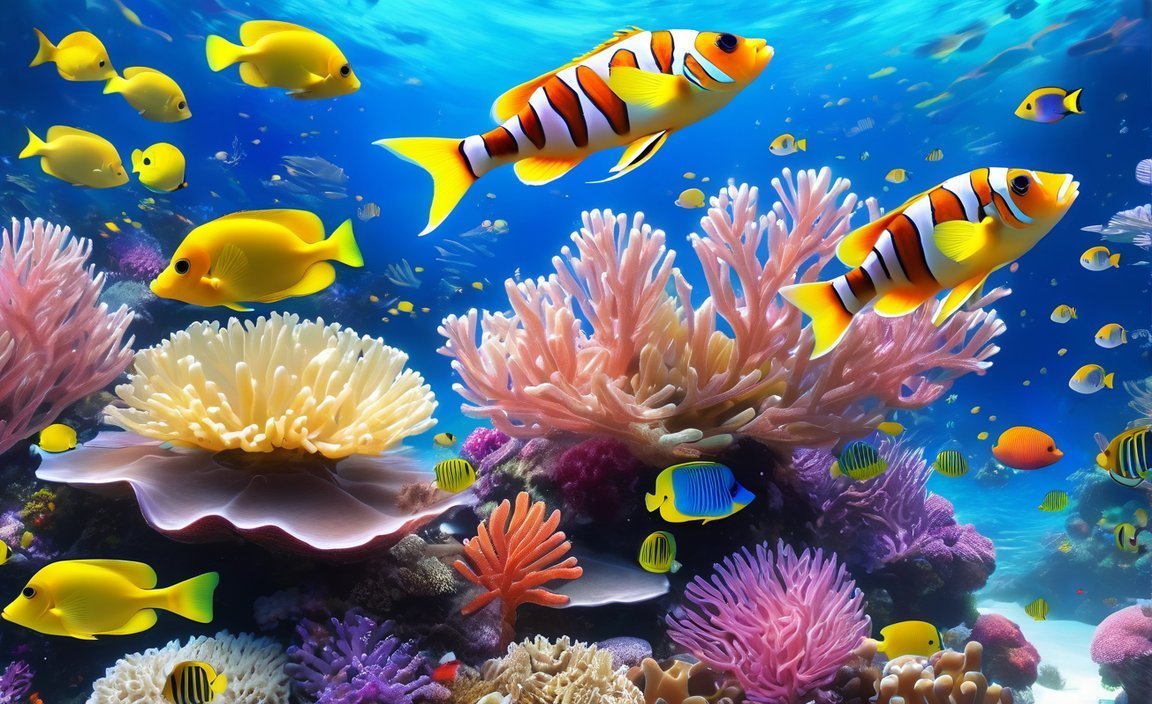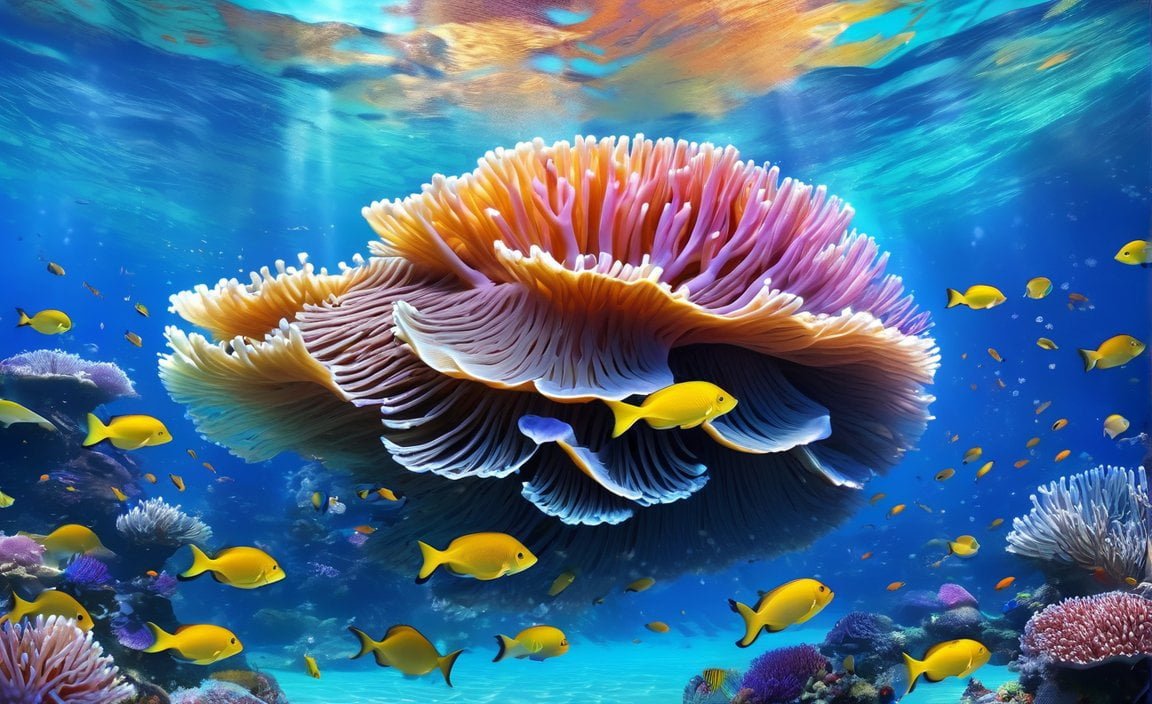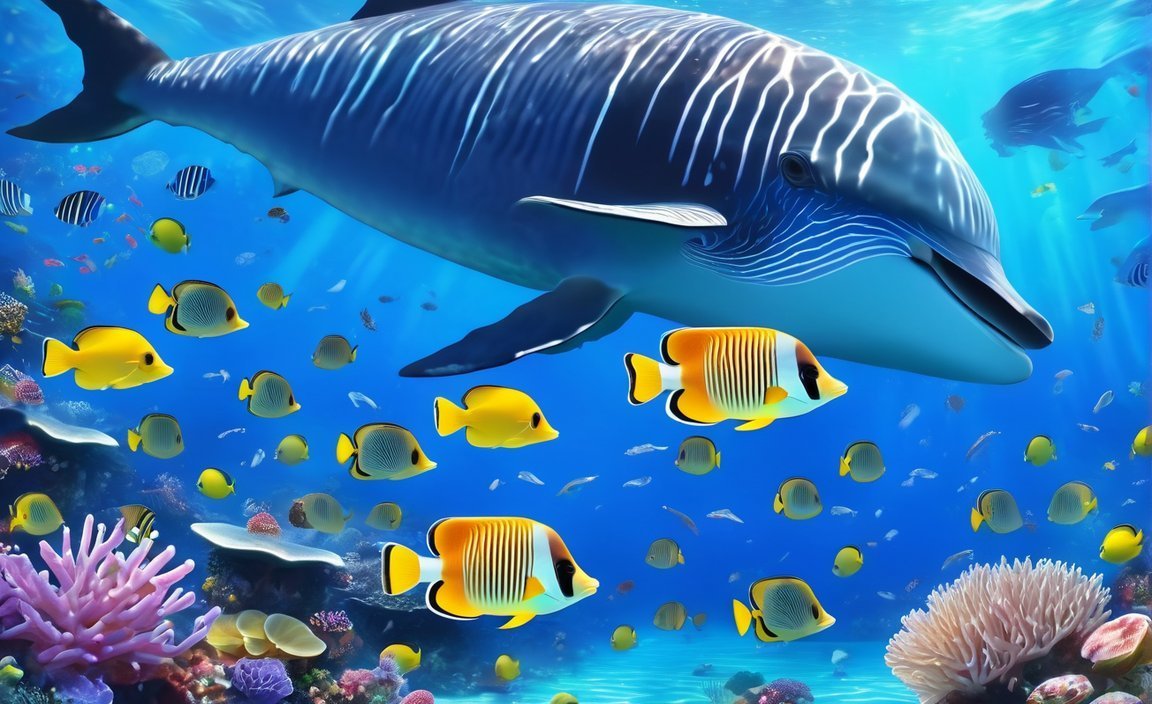Welcome to “Diving into Discovery: 10 Fascinating Marine Life Facts,” where we’ll explore the mesmerizing wonders hidden beneath the ocean’s surface. Prepare to be captivated as we unveil ten intriguing and fun facts about the diverse and enchanting world of marine life. From astonishing adaptations to astonishing behaviors, join us on this educational journey as we dive into the depths of knowledge and unravel the mysteries of the deep blue sea.

Key Takeaways:
- The speed of sound in water is nearly five times faster than in air.
- The oceans provide 99% of the living space on the planet and contain 50-80% of all life.
- Jellyfish have been around for more than 650 million years, predating dinosaurs and sharks.
- Electric eels can generate electricity sufficient to light up to 10 electric bulbs.
- Dolphins sleep with only half of their brain and one eye open to watch for predators and threats.
- The Great Barrier Reef is the largest living structure on the planet, located in the ocean.
- The blue whale is the largest animal on the planet, weighing up to 200 tons.
- The Mariana Trench, which is 36,070 feet deep, is the deepest part of the ocean.
- The sperm whale is the world’s largest predator and can be found in the ocean.
- The ocean is home to the largest animal migration, with over 1 million wildebeest migrating across the Serengeti each year.
10 Fun Facts About Marine Life
The world beneath the ocean’s surface is filled with wonders and surprises. From the incredible diversity of species to the amazing adaptations they possess, marine life never fails to captivate us. Here are 10 fascinating facts that will take you on an exciting journey through the mysteries of the deep sea.
1. The Speed of Sound in Water
Did you know that sound travels much faster through water than it does through air? At a staggering speed of 1,435 meters per second, sound underwater is nearly five times faster than in the atmosphere. This means that marine animals, such as whales, dolphins, and even fish, communicate and navigate in a sonic world that moves at an astonishing pace.
2. The Abundance of Life in the Oceans
The oceans cover about 71% of the Earth’s surface, providing an expansive habitat for countless organisms. Astonishingly, they house 99% of the planet’s living space, making the marine realm the ultimate frontier for exploration and discovery. It is estimated that between 50 to 80% of all life on Earth can be found beneath the waves, showcasing the immense biodiversity that the seas hold.
3. The Ancient Existence of Jellyfish
Jellyfish may seem delicate and otherworldly, but they have a lineage that predates both dinosaurs and sharks. These fascinating creatures have been inhabiting our oceans for more than 650 million years, their ethereal forms and graceful movements offering a glimpse into our planet’s ancient past.
4. The Electrifying Ability of Electric Eels
Imagine being able to light up not just one, but up to ten electric bulbs with your own body! Electric eels possess this remarkable capacity, producing electricity in specialized organs called electrocytes. By discharging electric shocks, they navigate their environment, hunt for prey, and defend against potential predators. Truly shocking, isn’t it?
5. The Sleep Habits of Dolphins
When dolphins sleep, they do so with only half of their brain at a time. This fascinating adaptation allows them to stay alert and aware of their surroundings even while resting. Dolphins also sleep with one eye open, keeping watch for any signs of danger. This unique sleep strategy ensures their safety, making them the ocean’s eternal guardians.
6. The Marvel of the Great Barrier Reef
Located in the ocean off the coast of Australia, the Great Barrier Reef is a natural wonder that simply takes your breath away. Stretching over 2,300 kilometers, it is the largest living structure on the planet. This mesmerizing ecosystem hosts a dazzling array of marine life, from colorful corals to majestic sea turtles, making it a haven for divers and marine enthusiasts alike.
7. The Enormity of the Blue Whale
No discussion on marine life would be complete without mentioning the blue whale, the largest animal on Earth. Weighing as much as 200 tons and reaching lengths of up to 30 meters, these gentle giants possess a size so awe-inspiring that it’s hard to fathom. Just witnessing a blue whale gracefully swimming through the ocean is an experience that leaves a lasting impression.
8. The Depths of the Mariana Trench
Venturing into the ocean’s depths, we find the Mariana Trench, a place of incredible depth and mystery. Plummeting to depths of 36,070 feet, it holds the title of the deepest part of the ocean. This abyssal realm is home to a myriad of unique creatures, adapted to survive an environment that is perpetually shrouded in darkness and pressure that would crush any living thing.
9. The Predatory Power of Sperm Whales
Sperm whales, the largest predators on the planet, dominate the oceans with their immense size and formidable hunting skills. They possess the extraordinary ability to dive to great depths in search of their favorite prey: colossal squid. With their massive heads and powerful bodies, sperm whales rule over the deep sea as true masters of the abyss.
10. The Epic Migration of Marine Life
Every year, the oceans witness the grandest animal migration on earth. Over one million wildebeest may traverse the Serengeti, but in the ocean, countless species embark on extraordinary journeys that rival this spectacle. From majestic sea turtles making their way to nesting beaches to humpback whales traveling thousands of kilometers to mating grounds, the ocean teems with life in motion.
As we delve into the realm of marine life, we unravel a world of wonders that parallel the wildest dreams of our imagination. From the mysterious communication of marine mammals to the extraordinary adaptations of deep-sea beings, the ocean holds a treasure trove of fascinating creatures. So, dive in and experience the magic of marine life, where enchantment and discovery await at every turn.
Have you ever wondered about the amazing secrets hidden within the depths of our oceans? Dive into the fascinating world of sea creatures with these 10 mind-blowing facts! Discover more about the incredible abilities and characteristics of these underwater marvels by clicking here.
Diving into Discovery: 10 Fascinating Marine Life Facts
The blue whale is a true marvel of nature, holding the prestigious title of being the largest animal to have ever existed. With its impressive size and captivating presence, this gentle giant never fails to leave us in awe. Let’s dive into the depths of the ocean and uncover some intriguing facts about the magnificent blue whale.
The Blue Whale: A Glimpse into Grandeur
- The blue whale, scientifically known as Balaenoptera musculus, is a marine mammal that reigns as the largest animal on our planet. It reaches a maximum confirmed length of 29.9 meters (98 ft) and can weigh up to a staggering 199 tonnes[^1^].
- This majestic creature boasts a long and slender body shape, complemented by a broad U-shaped head, thin and elongated flippers, and a small dorsal fin[^1^]. It is truly an embodiment of grace and power.
A Solitary Giant, United in Numbers
- While blue whales are typically solitary beings, they do engage in social behavior from time to time. In areas of high productivity, they can be found in pairs or even in large gatherings of over 50 individuals[^1^]. Imagine the sight of such a congregation of giants!
A Global Population: An Enigmatic Estimation
- The global population of blue whales is estimated to be between 5,000 and 15,000 mature individuals[^1^]. However, these numbers can be challenging to determine accurately due to the elusive nature of these underwater giants.
Unraveling the Blue Whale’s Origins
- The blue whale belongs to the family Balaenopteridae and diverged from other families approximately 10.48-4.98 million years ago[^1^]. It possesses a rich evolutionary history that has shaped its remarkable characteristics we admire today.
A Glimpse into the Past: Discovering Fossil Remnants
- Fossil evidence has provided invaluable insights into the blue whale’s existence. The earliest discovered anatomically modern blue whale fossil dates back to the Early Pleistocene, roughly 1.5-1.25 million years ago[^1^]. These precious remnants carry tales of bygone eras.
Unlikely Encounters: Blue-Fin Hybrids
- Blue whales have been known to interbreed with fin whales, leading to the fascinating occurrence of blue-fin hybrids[^1^]. These rare encounters between distinct species unveil the complexities of life beneath the waves.
Subspecies: A Tale of Diversity
- The blue whale exhibits remarkable diversity, with at least four recognized subspecies. These include the Northern subspecies, the Northern Indian Ocean subspecies, the Pygmy blue whale, and the Antarctic subspecies[^1^]. Each subspecies reveals its own unique characteristics and adaptations.
Geographic Separation: A Case for Distinction
- Blue whales off the Chilean coast may even represent a separate subspecies, given their geographic separation from other groups. Genetics, unique song types, and distinct characteristics contribute to their potential status as a distinct subspecies[^1^].
Conservation Concerns: Protecting a Natural Wonder
- Despite its grandeur, the blue whale faces various threats, including ship strikes, entanglement in fishing gear, and underwater noise pollution. Conservation efforts are crucial to ensuring the survival of this magnificent marine creature[^1^].
The Blue Whale: An Enduring Enigma
- The blue whale’s sheer size and enigmatic nature continue to fascinate scientists and nature enthusiasts alike. Its presence reminds us of the vastness and wonders that lie within our world’s oceans.
Key Takeaways:
– The blue whale is the largest animal known to have existed on Earth, reaching lengths of up to 29.9 meters and weighing up to 199 tonnes[^1^].
– Blue whales can be solitary but occasionally gather in pairs or groups of more than 50 individuals[^1^].
– The global population of blue whales is estimated to be between 5,000 and 15,000 mature individuals[^1^].
– Blue whales belong to the family Balaenopteridae and diverged from other families around 10.48-4.98 million years ago[^1^].
– The earliest known anatomically modern blue whale fossil dates back to approximately 1.5-1.25 million years ago[^1^].
– Blue whales can interbreed with fin whales, resulting in intriguing blue-fin hybrids[^1^].
– There are at least four recognized subspecies of blue whale, each with its own unique characteristics[^1^].
– Blue whales off the Chilean coast may represent a separate subspecies based on geographical separation, genetics, and distinctive song types[^1^].
– Conservation efforts are essential for protecting blue whales from various threats and ensuring their survival[^1^].
– The blue whale’s grandeur and enigmatic nature continue to inspire awe and fascination[^1^].
Click here to know more about blue whales
Click here to learn about blue whale vocalizations
[^1^]: Blue whale – Wikipedia
Coral Reefs: The Diverse Ecosystems of the Sea
Coral reefs are often called the rainforests of the sea, and it’s not hard to see why. These vibrant and diverse ecosystems are home to a staggering number of species and play a crucial role in supporting marine life. In this article, we will dive into the fascinating world of coral reefs and uncover some intriguing facts that will leave you in awe of the wonders beneath the ocean’s surface.
The Builders of the Deep
Coral reefs consist of individual polyps, which come in various forms such as stony corals, black corals, sea anemones, soft corals, seafans, organpipe corals, and blue corals. With approximately 4,820 species, corals display a remarkable diversity. The hexacorals, characterized by smooth tentacles in multiples of six, and the octocorals, with eight tentacles, make up this vast coral family. These incredible organisms construct intricate structures by secreting calcium carbonate, forming the framework that supports the entire reef ecosystem.
An Ocean of Biodiversity
Coral reefs support an estimated 25 percent of all known marine species, making them one of the most biodiverse ecosystems on Earth. They are home to more than one million species of plants and animals, some of which are found nowhere else in the world. From colorful fish darting between the corals to mesmerizing sea turtles gliding through the water, the array of life that thrives within these reef communities is truly awe-inspiring.
Guardians of the Deep
While coral reefs often exist in the shallows, they are also the only habitat-forming features in deep, dark waters. Deep-sea corals, found in the depths of the ocean, are crucial components of this habitat. These corals vary in size and are specially adapted to survive in extreme conditions, including low temperatures and limited sunlight. They provide valuable shelter and feeding grounds for a wide range of deep-sea species, contributing to the overall health and biodiversity of the marine ecosystem.
Valuable Natural Treasures
Coral reefs not only hold immense ecological importance but also have significant economic value. Red corals, highly prized for their use in jewelry and decorative items, hold a special place in the market. The United States alone imports around one million live corals annually, reflecting the demand for these stunning creations of nature. However, it is crucial to strike a balance between responsible harvesting and conservation efforts to ensure the long-term survival of these magnificent coral ecosystems.
Protecting the Reefs
The fragile nature of coral reefs makes them vulnerable to various threats, including climate change, pollution, and overfishing. Conservation efforts are crucial to safeguard these delicate ecosystems and the species that depend on them. Organizations like the Smithsonian Ocean and Pêches et Océans Canada provide valuable information and resources for understanding and protecting coral reefs. By raising awareness and implementing sustainable practices, we can contribute to the preservation of these vital habitats for future generations.
Key Takeaways:
- Coral reefs are often called the rainforests of the sea due to their high biodiversity and significance as marine habitats.
- Coral reefs consist of individual polyps, with over 4,820 species exhibiting a wide range of forms and characteristics.
- These diverse ecosystems support approximately 25 percent of all known marine species, representing a remarkable array of plants and animals.
- Deep-sea corals play a crucial role in deep-sea habitats, providing shelter and food sources for numerous species.
- Red corals, highly valued for their beauty, are imported in significant quantities by the United States.
- Conservation efforts are essential to protect coral reefs from threats such as climate change and overfishing.
Sources:
– Smithsonian Ocean: Coral Reefs and Corals
– Pêches et Océans Canada: Coral Reefs: Rainforests of the Sea
The Mimic Octopus: Master of Disguise
The mimic octopus is a truly extraordinary creature that possesses an incredible gift: the ability to imitate various marine animals. Found in the Indo-Pacific region, this fascinating species has captured the attention and admiration of marine biologists worldwide. Through its remarkable skills in disguise and mimicry, the mimic octopus has become a true marvel of the underwater world.
Adapting to Survive
In the diverse ecosystems of the ocean, survival often depends on the ability to blend in or deter predators. The mimic octopus has taken this strategy to a whole new level. Using specialized cells called chromatophores that allow it to change color and texture, this clever cephalopod can flawlessly mimic the behaviors and appearances of other marine animals.
A Master Impersonator
The mimic octopus showcases its ability to imitate various marine animals with astonishing precision. It can effortlessly transform itself into sea snakes, lionfish, eels, stingrays, and even jellyfish, fooling both predators and prey alike. By masquerading as toxic or venomous creatures, the mimic octopus effectively deters potential threats.
Strategic Camouflage
The mimic octopus displays remarkable intelligence and adaptability. It can modify its mimicry pattern based on the specific threat it faces. This strategic behavior allows it to stay one step ahead of its predators and increases its chances of survival in the vast expanses of the open ocean.
Hunting Techniques
While the mimic octopus is a master of disguise, it also possesses impressive hunting techniques. Using a jet of water expelled through its funnel, it gracefully glides over the sand, searching for its preferred prey, which includes small fish, crabs, and worms. This combination of stealth and precision makes the mimic octopus a formidable predator in its own right.
Unique Habitat and Predators
The mimic octopus gravitates towards river mouths and estuaries, where it can find ample protection and hiding places. In these environments, it can take full advantage of its mimicking abilities. However, even with its astonishing disguise, the mimic octopus faces a range of predators, including golden trevally, jellyfish, stingrays, sea snakes, lionfish, and even humans.
A World of Wonders
The mimic octopus stands as a testament to the beauty and complexity of marine life. Its ability to imitate various marine animals not only showcases the wonders of evolutionary adaptation but also highlights the incredible diversity that exists beneath the ocean’s surface. By unraveling the mysteries of the mimic octopus, marine biologists continue to delve into the secrets held by our enchanting underwater world.
Key Takeaways:
- The mimic octopus has the remarkable ability to imitate various marine animals.
- It uses specialized cells called chromatophores to change color and texture.
- By impersonating toxic or venomous creatures, the mimic octopus deters predators.
- The mimic octopus can modify its mimicry pattern based on the specific threat it faces.
- It hunts with grace and precision, using a jet of water to glide and search for prey.
- The mimic octopus can be found in river mouths and estuaries, where it seeks protection.
- Despite its incredible disguises, the mimic octopus has predators such as golden trevally and jellyfish.
- Studying the mimic octopus illuminates the captivating diversity of marine life.
SOURCES:
– National Geographic – Mimic Octopus Facts
– Ocean Fauna – Mimic Octopus: Habitat, Description & Fun Facts

FAQ
Q1: How fast does sound travel in water compared to air?
A1: Sound travels approximately five times faster in water than in air, with a speed of 1,435 meters per second.
Q2: What percentage of all life is found in the oceans?
A2: The oceans contain 50-80% of all life on the planet, providing 99% of the living space.
Q3: How long have jellyfish been around?
A3: Jellyfish have been around for more than 650 million years, pre-dating dinosaurs and sharks.
Q4: How much electricity can electric eels produce?
A4: Electric eels are capable of producing electricity sufficient enough to light up to 10 electric bulbs.
Q5: How do dolphins sleep and remain alert at the same time?
A5: Dolphins sleep with only half of their brain and with one eye open to watch for predators and threats.
Q6: What is the largest living structure on the planet?
A6: The Great Barrier Reef, located in the ocean, is the largest living structure on the planet.
Q7: What is the largest animal on the planet?
A7: The blue whale, weighing as much as 200 tons, holds the title for being the largest animal on the planet.
Q8: What is the deepest part of the ocean?
A8: The Mariana Trench, which is 36,070 feet deep, is the deepest part of the ocean.
Q9: What is the world’s largest predator?
A9: The sperm whale, found in the ocean, holds the status of being the world’s largest predator.
Q10: What is the largest animal migration?
A10: The ocean is home to the largest animal migration, with over 1 million wildebeest migrating across the Serengeti each year.
- iVoterGuide 2024: Your Guide to Christian Values-Based Voting - November 24, 2024
- Ed Gein’s House of Horrors: Rare Crime Scene Photos and the Disturbing Truth - November 24, 2024
- Unveiling the Faces of Fear: Exploring the Lives of Jack the Ripper’s Victims Through Rare Photographs - November 24, 2024














